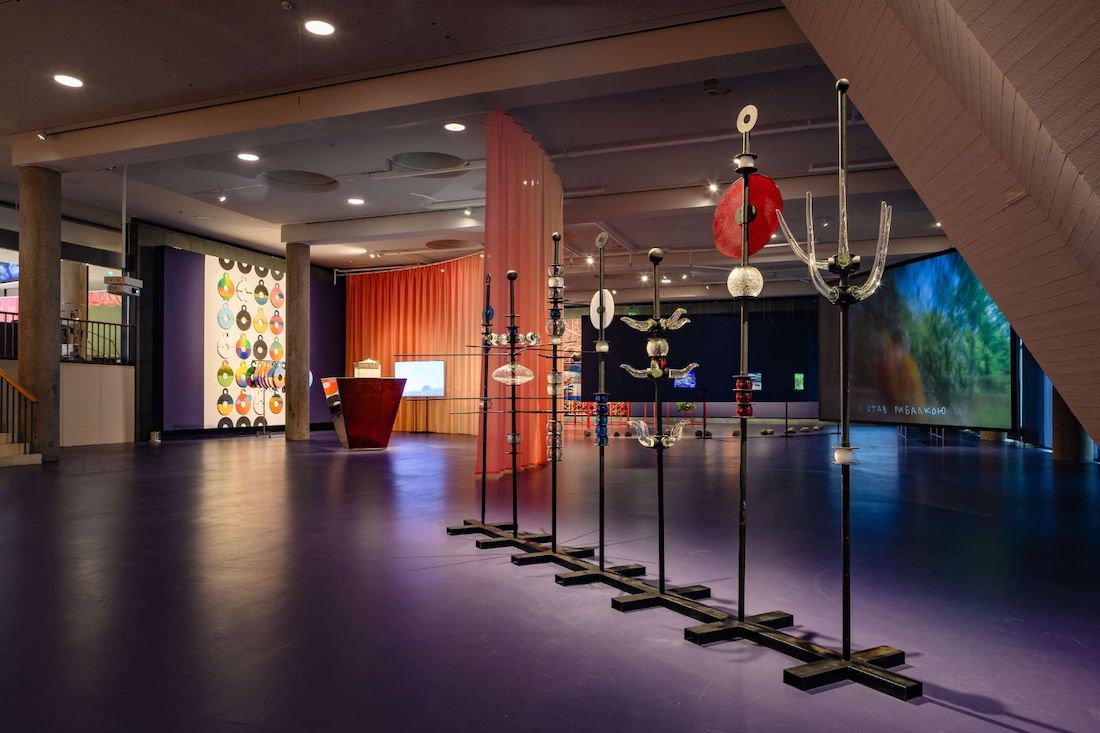Photos by Laura Fiorio
On January 14th, the exhibition "As Though We Hid the Sun in a Sea of Stories" closed at the Haus der Kulturen der Welt, Berlin. It was dedicated to multiple worldviews and narratives that have existed along, and often in contradiction, with interchanging political regimes on the vast territories of North Eurasia. Stories played an important part in the processes of their conservation and imagination. As an afterword to the exhibition, EastEast editor Konstantin Koryagin asked the curators to share their reflections on the place of imaginary worlds in their lives, while the Indian artist Afra Shafiq recorded a playthrough of her video game Nobody Knows For Certain, which reinterprets the aesthetics and content of translated versions of Soviet children's literature.
We have been wary of Tuesdays since we were kids. "One should never initiate anything on Tuesday," they said, whether it’s reading a new book, sewing, or venturing on a journey. And we were also forbidden to have a bath on these days. Long story short, anything that had something to do with transformation was strictly prohibited. However, grown-ups could never explain what was so special about Tuesdays. At the same time, we were told bedtime stories. Interweaved with myths and legends, they formed a vast magical space that we never considered fantasy or illusion but saw them as a form of knowledge accumulated and experienced by those who had lived before us.
One of these stories was the tale of Bibi Seshanbe, literally, "The Lady of Tuesday." There is no need to relate the plot because it follows closely the familiar fairy tale about Cinderella. I am not a great fan of the version that we all know from the Brothers Grimm or the cartoon, but I do like our Central Asian version, because the main character is anonymous and every young woman can identify with her. The Fairy Godmother who gives her the blessing is the Lady of Tuesday.
In our retelling, the presence of animals is very important; it is this connection to animalism that survived through Islam to the present day. The girl has a cow and a chicken as symbols of maternity and fertility that her mother leaves to her. These animals sacrifice their lives for her happiness. A beautiful cycle of death and sacrifice affirming and supporting life.
In English, the name Cinderella comes from the French word for ashesFrench word for ashesIn the original Russian of the interview, the fairytale name "Золушка" also derives from the Russian word for ashes, "зола" — translator’s note. In Bukhara and Samarkand, we have a ritual of burning 40 candles made of cotton and animal grease and telling Kissai Bibi Seshanbe, the very tale of the Lady of Tuesday as a Fairy Godmother. When the candles burn out, participants use their ashes to paint the face of the young woman who initiated the ritual. Usually, it is performed to bring good luck and to get a blessing before starting something new, for example, to passing exams or getting pregnant.
There’s this entanglement—you can never start anything on Tuesday. It turned out that this is the day when we worship Bibi Seshanbe, the fairy, the Lady of Tuesday. Then there were bedtime stories. Then again, it turned out that they were legends about a girl willing to be initiated into adult life, and they gave rise to the ritual. All of this exists here and now, not somewhere in an imaginary world. It seems like this story has not yet become a tale, since women still address the Lady of Tuesday; the ritual lives on.
Working with oral stories for me is a way to be more aware of myself and to connect with my own culture. I believe this is a fundamental feature of the decolonisation of the mind and artistic practice. The story of Bibi Seshanbe has been a great inspiration to me. Looking at how it permeates reality, I searched for a contemporary figure to embody the Lady of Tuesday, and I found Bibisora Oripova, burn surgeon, head of the crisis center and shelter for women in Samarkand. She operates on women who had suffered from domestic violence and set themselves on fire.
I made an eponymous video about the story, the ritual, and the custom of being wary of Tuesday transmitted to me by my grandmother, which I presented at Documenta 15 in 2022. While working on the video, I understood that certain stories never become tales because there still are real people who, just like Bibisora Oripova, embody the essence of the fairytale characters.
For me, a story is not about a specific literary plot (this idea came later with Indian fairy tales and literary studies), but about a childish, almost pre-cultural sense of charm emanating from the world. It is something about being thrown into the coziness of the world where there is no danger—there is your mother and grandmother, a forest and a river, and your family's country house is still intact.
In this sense, a fairytale is about the way you build your relationship with your surroundings based on these premises. For example, in spring and in summer, when in the countryside, I would draw on concrete pathways with ground petals. On our allotment, these pathways connected an old saman hut that had been built instead of a turluk mud hut, a summer kitchen, and a brick house that was being constructed at the time. I would wait until it rained and watch warm torrents colored with the flower ink disappear into the dark ground. And then, often, I would draw again, so that my family and our guests would step on a carpet of bright squares and stripes.
Of course, this kind of enchantment can be reexperienced. But what makes it come back? That I don’t know. Sometimes a wind would blow in a special direction. Or a smell would remind you of that state. I think the most important thing is to share this feeling with friends as often as possible. It’s as if you share a story and it travels far away and then, maybe, one day it comes back to you as a specter to remind you of a forgotten tale.
Yes,
I want to tell tales softly, to put them inside, to blow them in like in Piraeus, who would blow a little something into Anestis’ ear. This tale killed him; he was found somewhere on the outskirts.
I am writing this text slowly approaching the town of Fulda. The one where the Brothers Grimm were from. Their tales were never significant to me. The Soviet translation collected dust somewhere on a shelf. Just like the Soviet edition of the Tales of the Peoples of the World, it had always slightly frightened me. The name Fulda, however, inspires sincere admiration to me. Gulden, poodle, family name of my landlord from Schaerbeek, from the days gone by. It is much more fairytale-like, it is much closer than the German brothers. Wilhelm died in December 1859, after completing the letter D. Jacob survived his brother by almost four years and managed to complete the A, B, C, and E. They never got to the most fabulous letters.
I remember concocting a fable about a monument. I was in Odessa, at the Karl Marx's Square: right there, many years later, a bar opened with a marvelous name; right there, my friend’s footprint took shape on a white jacket, protecting prophets and women. Twelve of them. I imagined the adventures of a monument. In a way, now I do somewhat similar work.
Tales did swiftly come to an end in my childhood: they transformed into my grandmother's stories of German occupation that sounded like tales about catacombs, steamboats, bombs, and gray hair.
Living in Odessa from time immemorial, it was difficult, from the very beginning, from my very childhood, to avoid the linguistic confusion. Etched in my memory is the name Laur-Bălaur. Făt-Frumos as well.
Then there was a book about a fire brigade that extinguished fires in Stalin-era buildings. A marvelously illustrated book. Perhaps, this is where my interest in Moscow Conceptualism comes from. Firefighters, however, interest me more.
Oh, speaking of tales, somehow the Little Round Bun and Pinocchio came to my mind. Imagine what their crossover would look like.
Ilia Zdanevich's are the stories for me, they enable my every breath.
The tale for me is his Parizhachi, a hare and a hedgehog.
Editor's Note: Soviet illustrated editions of fairy tales were very popular in India and form a significant part of childhood memories for the generation born between 1960-1980. Nobody Knows For Certain is a video game born out of a research project about these books. Just like in real life, tales in this game are both a place of control and subversion. It is a world where state ideology exists alongside tales of the peoples of the worlds, and Soviet Avant-Garde is inseparable from popular prints and miniature lacquer painting. To complete the game, follow the link to download. Here you can read more about the "As Though We Hid the Sun in a Sea of Stories" exhibition.
Translated from Russian by Liya Ebralidze







